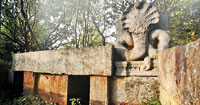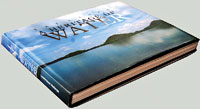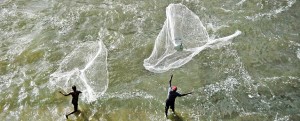Dive in and soak in the wonder
View(s):Theirs has been a fruitful collaboration. Two previous books one on Gardens of Lanka and the other on Sri Pada: Peak Heritage of Sri Lanka were immediately successful and the authors have spared no pains with this volume either. Diplomat Sarala Fernando and nature photographer Luxshmanan Nadaraja both share a deep love and great appreciation for this land and their work is wholly aimed at making their fellow countrymen and women realise its wonders, both natural and man-made.

Sevanagala Urusita Wewa sluice
Water, Sarala writes, in the eyes of many is the country‚Äôs most precious resource, indeed at the heart of its civilization. Luxshmanan Nadaraja explains his motivation very clearly in an end-note: that conventional explanations have not been adequate to understand our past adequately. ‚ÄúI fear that we have but traces of an ancient civilization and a ‚Äėlost‚Äô people that may have been obscured by dominant narratives of history and culture that begin with Vijaya and Buddhism‚ÄĚ.
It is a large sweep that the book encompasses, through a collection of essays from writers whose expertise is well known: R.L. Brohier, Somasiri Devendra, Bhante Shravasti Dhammika, C.M. Madduma Bandara, Kusum Athukorala, E.I.L. Silva, Herath Bandaratillake, H. Manthrithilake, Arumugam Kandiah, Anouk Ilangakoon, Anslem de Silva, Ramani Shirantha, Sarath Kotagama and Deepthi Yakandawala.
In the first part of the book Dr. R.L. Brohier and C.M. Madduma Bandara offer a perspective of the country‚Äôs ancient hydraulic system, its rivers and tanks, issues of conservation and management. ‚ÄúI have seen small tanks in the thousands,‚ÄĚ Dr. Brohier writes and considering he served the Survey Department from 1910 to 1949, there was no major man-made lake or ancient channel that he had left unvisited. He turned to village story-teller and temple recluse, he says, for such folk memories that had survived six centuries of abandonment. His is a fascinating account probing the origins of pastoral knowledge dating it to times even before the arrival of Prince Vijaya.
The first reference to the construction of a reservoir dates back to 4th Century BC, a tank built by Prince Anuradha.Brohier states that a Topographical survey of the island in 1904 disclosed that there were 11, 200 small reservoirs in Anuradhapura and the Northern Province alone. ‚ÄúThe Portuguese in their maps referred to them as TANQUE which in their language means ‚Äėlakelet‚Äô. The British borrowing from the Portuguese perpetuated the inartistic ‚Äėtank‚Äô which conveys a very inadequate picture of these beautiful land-locked man-made sheets of water, a source of admiration in every age of their history and a theme on which many imaginations have pondered,‚ÄĚ he writes.
Lanka was a port of call for ancient mariners and Somasiri Devendra describes with his usual poetic flair the early settlers, the monks and ambassadors, the merchants and mariners who sailed to Lanka in ‚ÄėThe Island, the People and the Sea‚Äô while Bhante Shravasti Dhammika explores water‚Äôs association with many religions.

Book facts Sri Lanka A Heritage of Water Photography by Luxshmanan Nadaraja Edited by Sarala Fernando Published by Sarala Fernando and Luxshmanan Nadaraja Reviewed by Renuka Sadanandan
Herath Manthrithilake captures the beauty of the ‚ÄėLagoons of Sri Lanka‚Äô in his evocative chapter. That Sri Lanka has as many as 82 lagoons of different sizes and shapes along its 1,338 km long coastline each endowed with different characteristics is not widely known.The writer stresses that the present knowledge of the coastal lagoons, their evolution, eco-hydrology, eco-system processes and dynamics, the value of goods and services provided is incomplete adding that many are especially vulnerable to climate change and managing them should be of critical importance. There is still time for us to act, he urges.

Rajangana spill
Sri Lanka, the events of the recent past have amply shown, has not escaped the issues confronting the modern world. Though water has been considered abundant, climate change has had its impact on the aquatic eco-systems and environmental experts such as Anslem de Silva, Anouk Illangakoon, Sarath Kotagama and Deepthi Yakandawala have written not just on land and marine mammals, birds and plants but conservation worries. The book also throws up some fascinating nuggets like Anouk Illangakoon‚Äôs note on ‚ÄėThe Otter in Sri Lanka‚Äô, providing little known information of the Eurasian otter ( Lutra lutra), elusive and nocturnal but apparently widespread in the wetland areas even found in cities such as Colombo and Kandy!
Climate change also figures in Kusum Athukorala‚Äôs essay on ‚ÄėWomen, Water and Climate Change in Sri Lanka‚Äô where she writes of the provision of community water schemes to rural villages calling for support for women at the ground level. E.I.L Silva touches on the burning issue of Chronic Kidney Disease of unknown etiology. In Water for Jaffna, Arumugam Kandiah strikes a more personal note laying out the ground conditions and outlining the Arumugam Plan to utilize monsoon rain water which is not without its drawbacks as the writer points out.
The book also offers some refreshing inclusions like the chapter on the Kanneliya-Dediyagala-Nakiadeniya (KDN) International Biosphere Reserve, the tropical rainforest in the south which writer Ramani Shirantha recommends as one of the top freshwater faunal hotspots of the world. So too the chapter on Aquatic Plants where author Deepthi Yakandawala not only touches on the blooms well linked to the country’s history and culture like the lotus, manel, olu and kumudu but also its wealth of sedges, rushes, sundews, herbs and free-floating plants like the Japan Jabara (water hyacinth) which was such a pest that the Water Hyacinth Ordinance was enacted in 1909 to curb its spread. Almost 90 years later the country is still battling it.
One can sense that Luxshmanan Nadaraja is in his element here and has travelled extensively for these images. The book is lavishly illustrated Рseascapes and shorelines to the sunlit tanks and tranquil lagoons, breathtaking hillsides with torrents descending and the occasional image of the people or fauna, even little noticed detail on ancient sluice gates. The reader is left with a sense of awe at the photographer’s eye that captures with such delicacy and precision: one can almost feel the cool mist wreathing the Bibile hillside and virtually touch the droplets of water clinging to a frond in the Peak wilderness or marvel at the detail in the shrine to God Ganesh at Muthuiayankadu in Mullaitivu.
Disappointingly, only terse captions accompany the stunning photographs. In Sarath Kotagama‚Äôs chapter on ‚ÄėWater Birds of Sri Lanka‚Äô the accompanying images give the place names but not the birds. Deepthi Yakandawala‚Äôs chapter on ‚ÄėAquatic Plants‚Äô maybe the exception- well captioned with the plants being given their scientific as well as common names.
Though printed in the coffeetable book format generally designed for browsing, ‚ÄėWater‚Äô is a book you need to spend time with to digest fully this country‚Äôs bountiful heritage of water and the challenges for the future.
The book designed by Nelun Harasgama Nadaraja is now available for sale at leading bookshops priced at Rs. 6,800.


